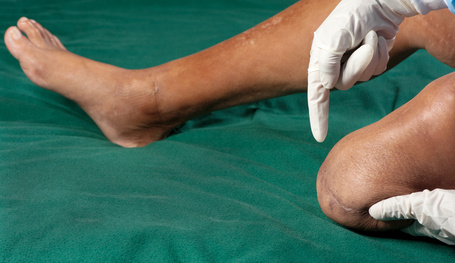On victim's with Open Chest Wounds a higher value is placed on the avoidance of providing dressings. The life-threatening risk is to cause tension pneumothorax inadvertently when compared with other risks associated with an Open Chest Wound.
Dressing Open Chest Wounds: First, activate the Emergency Response System. Check to see if there’s more than one open wound (for more than one wound determine if dressing will be applied). Remember, the dressing should only be applied if there is rapid blood loss. Remove clothing (leave stuck clothing). Cut dressing but make sure it’s larger than the wound. Seal the wound to prevent the loss of blood (apply pressure if needed). Never remove objects from the wound.
Punctured Wounds can be severe. It's very dangerous if the wound gets infected. If the wound has excessive bleeding, make sure to call 911. Remember, if the patient falls unconscious or is non-responsive without a pulse make sure to call 911 and perform CPR.
Treatment:
1. Stop the bleeding.
2. Apply thorough pressure (seek EMS attention if bleeding is excessive.
3. Clean the wound thoroughly with water and soap (stay clear of the injury itself).
4. Apply an ointment such as Neosporin.
5. Provide a pain reliever such as Advil.
6. (Re) wrap the wound to keep the wound from infection.
7. Seek medical attention at the nearest hospital if the injury worsens.
8. Have the patient get a Tetanus or Tetanus Booster shot.
Amputations. There are several steps to follow when treating amputations.
Treatment:
1. Always practice universal precautions.
2. Call 911 immediately.
3. If the patient isn’t breathing, perform CPR.
4. Apply direct pressure. Make sure to raise the injured area. Use a tourniquet or tight bandage, if needed.
5. If possible clean the amputated part and make sure to keep it with the patient.
6. Wrap the part in a cloth and put it in a plastic sealed bag inside of ice water.
7. If the amputated part is below the heart, make sure to raise the legs 12 inches above the heart.
8. Watch for any signs of shock.
Cuts & Scrapes. There are several basic steps to follow when aiding Cuts & Scrapes.
Treatment:
1. Stop the bleeding.
2. Apply thorough pressure (seek EMS attention if bleeding is excessive or cut is deeper than 1/4 inch).
3. Thoroughly clean the cut/scrape with water and soap (stay clear of the injury itself).
4. Apply an ointment such as Neosporin.
5. Provide a pain reliever such as Advil.
6. (Re) wrap the injury to keep it from infection.
7. Seek medical attention at the nearest hospital if the injury worsens.
8. Have the patient get a Tetanus or Tetanus Booster shot.
Keeping the wound clean is crucial. Make sure the patient gets tetanus or booster shot.






